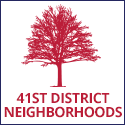I sweat the details.
Four schools in the 41st District will be renovated in the first year of the $1 billion plan that will eventually transform every school in the City.
Senator Lisa Gladden, Delegates Jill Carter, Nathaniel Oaks, and I have attended planning meetings with students, their family members, and neighbors at Arlington and Pimlico Elementary/Middle Schools, Lyndhurst Elementary, and Forest Park Senior High. 3,000 square feet in each facility will be designed for community use.
A certain portion of slots revenue is allocated for economic and community development in the neighborhoods surrounding Pimlico Race Track.
In Northwest Baltimore, we’ve worked with neighborhood leaders to help them determine how $1.5 million will be spent. Parking for patrons of the Reisterstown Road Enoch Pratt Library branch, improvements to Luckman and Northwest Parks, and construction of the Hatzalah Community Center are some of the uses to which this money will be put.
Major renovation of Park Heights has also begun with this money, and Liberty Heights neighborhoods will benefit when the Baltimore City facility opens next year.
Our economy and our environment require a 21st Century mass transit system. On its way from Social Security in Woodlawn to Bayview Hospital in East Baltimore, the Red Line will run through the Edmondson Avenue corridor.
Where stops are located and the safety of pedestrians crossing Edmondson Avenue are crucial details. So are jobs. At our urging, a job forum will be held at the Westside Skills Center on Saturday.
After the bill passes in Annapolis, there’s a lot of work to do back home.








